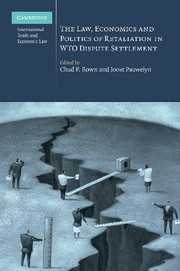Book contents
- Frontmatter
- Contents
- List of tables and figures
- Contributors
- Introduction: trade retaliation in WTO dispute settlement: a multi-disciplinary analysis
- PART I Background and goal(s) of WTO retaliation
- PART II A legal assessment after ten arbitration disputes
- PART III An economic assessment after ten arbitration disputes
- 6 The economics of permissible WTO retaliation
- 7 Sticking to the rules: quantifying the market access that is potentially protected by WTO-sanctioned trade retaliation
- PART IV The domestic politics and procedures for implementing trade retaliation
- PART V Problems and options for reform
- PART VI New frontiers and lessons from other fields
- Index
7 - Sticking to the rules: quantifying the market access that is potentially protected by WTO-sanctioned trade retaliation
Published online by Cambridge University Press: 26 February 2010
- Frontmatter
- Contents
- List of tables and figures
- Contributors
- Introduction: trade retaliation in WTO dispute settlement: a multi-disciplinary analysis
- PART I Background and goal(s) of WTO retaliation
- PART II A legal assessment after ten arbitration disputes
- PART III An economic assessment after ten arbitration disputes
- 6 The economics of permissible WTO retaliation
- 7 Sticking to the rules: quantifying the market access that is potentially protected by WTO-sanctioned trade retaliation
- PART IV The domestic politics and procedures for implementing trade retaliation
- PART V Problems and options for reform
- PART VI New frontiers and lessons from other fields
- Index
Summary
Introduction
Most empirical studies of the effect of implementing the multilateral agreements negotiated during the Uruguay Round pointed to the potential for small positive, but nonetheless economically significant, gains for the members of the World Trade Organization (WTO) (Brown, Deardorff and Stern 1994; Schott 1994). Many factors will determine whether these potential gains are fully realised and perhaps one of the most important is whether WTO members actually implement their commitments and do not renege on them subsequently. Since these latter actions reflect explicit choices by governments after the Uruguay Round was signed, one is entitled to ask what incentive do WTO members have to stick to the rules, so to speak? This question is pertinent when mercantilistic reasoning is still thought to pervade the corridors of power.
The drafters of the Uruguay Round agreements were cognisant of the need to encourage WTO members to fulfil their obligations and introduced into the WTO architecture an enhanced dispute settlement the legal aspects of this reformed procedure (see, for example, Jackson 1998a, b). Here, however, I will focus on the implications of the bilateral nature of sanctions on trade in goods and services for the strength of incentives supplied to a country to adhere to its market access commitments. This is not to suggest that other forms of retaliation are unimportant (as the discussion of the ‘cross-retaliation’ issue makes clear). Indeed, if my analysis found that only weak compliance incentives were created by the potential threat of trade sanctions, then this might suggest a greater role for non-trade-based sanctions.
- Type
- Chapter
- Information
- Publisher: Cambridge University PressPrint publication year: 2010
- 6
- Cited by

